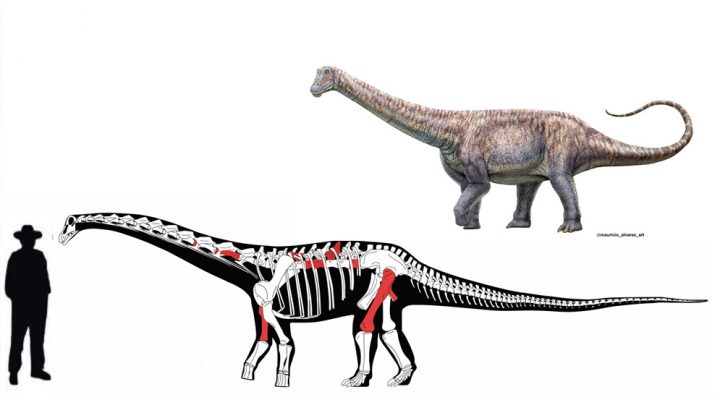EXACT AND NATURAL SCIENCES
Scientists find fossil of a new species of titanosaur that lived in the Atacama region during the late Cretaceous epoch
A researcher of the Council participated in the discovery that took place in Chile.
Arackar licanantay was called this new species of titanosaur found in the desert of Atacama, in the north of Chile. This animal -the second of this type found in the same area- provides new information about the evolution of this group. The study was published in Cretaceous Research.
In the research team, there is an Argentine scientist. He is Bernardo González Riga, CONICET Independent researcher at the Instituto Interdisciplinario de Ciencias Básicas (ICB, CONICET-UNCUYO) and director of the Laboratorio y Museo de Dinosaurios” of the Universidad Nacional de Cuyo.
“The titanosaurs were herbivores with a long neck, small head and robust limbs. They were animals of gregarious and oviparous habits. Most of them were large size but some were literally ‘giants among giants’ of 70 tons and 30 feet long. This is the case of the Argentine genera Notocolossus Artinosuaurus, Puertasaurus and Patagotitan,” explains the scientist.
Although these dinosaurs spread across all continents during the Cretaceous period, there were lots in South America, where they developed a great diversity of sizes and shapes. There are eighty species known in the world and fifty-five come from our country. So far, 41 species have been discovered in Argentina, 11 in Brazil, 1 in Ecuador and 2 in Chile with the present finding. “Anatomically, titanosaurs have feet with five toes, with a notable reduction in their phalanges, leaving three curved claws. In contrast, the forelimbs lose their phalanges making the metatarsals orient vertically forming a vertical crescent, specially adapted to support their weight,” González Riga describes.
The first fossil bones of Arakar licanantay were found in the 1990s by geologist Carlos Arévalo, from the Servicio Nacional de Geología y Minería de Chile. Later, paleontologist David Rubilar-Rogers, from the Museo Nacional de Historia Natural, led this study in which they found new fossil materials.
The dinosaur found was called “osamentas atacameñas” in Kunza (language of the original people of the region). It lived during the late Creataceos epoch and was 20.3 feet long. The researchers found different cervical and dorsal vertebrae, and limb bones. According to the study, this species would be a sub-adult since possibly the largest specimens of species would reach eight meters (26.2 feet) in length. “The relatively small size of this species is also recorded in Argentina (Saltasaurus and Neuquensaurus) and implies that during the late Cretaceous many species experienced a reduction of its body size, a fact that requires detailed evolutionary studies. Coincidentally, ecosystems suffered great changes, particularly linked to variation in sea level,” the researcher comments.
The discovery of this sauropod enhances the knowledge on the titanosaurs of the Lithostrotian lineage, which became extinct at the end of the Cretaceous, 66 million years ago. Phylogenetic studies place Arackar close to Rapetosaurus from Madagascar and Isisaurus from India.
González Riga is one of the experts on sauropod dinosaurs in Latin America and his role in the study was fundamental to classify the discovered species: “A collaborative spirit is fundamental to advance. There are few specialists in each group of fossil organisms or in each specialty and, therefore, we must value the human potential that Argentina has. The experience of working with colleagues from other countries is extraordinary and the learning is always mutual. I am always grateful for that. A scientist, by definition, never stops learning. And that work is done with all the values of teamwork,” concludes the researcher.
By Leonardo Fernández
References:
Rubilar-Rogers, D.; Vargas, A. O.; González Riga, B.; Soto-Acuña, S.; Alarcón-Muñoz, J.; Iriarte-Díaz, J.; Arévalo, C.; Gutstein, C. S. (2021). Arackar licanantay gen. et sp. nov. a new lithostrotian (Dinosauria, Sauropoda) from the Upper Cretaceous of the Atacama Region, northern Chile. Cretaceous Research. doi:10.1016/j.cretres.2021.104802.
About the study:
David Rubilar-Rogers. Museo Nacional de Historia Natural, Chile
Alexander O. Vargas Universidad de Chile, Chile
Bernardo González Riga. ICB – Universidad Nacional de Cuyo
Sergio Soto-Acuña. Museo Nacional de Historia Natural – Universidad de Chile, Chile
Jhonatan Alarcón-Muñoz. Universidad de Chile, Chile
José Iriarte-Díaze. University of the South, USA
Carlos Arévalo. Marchant. Pereira 1931, Chile
Carolina S. Gutstein. Consultora Paleosuchus Ltda., Chile
